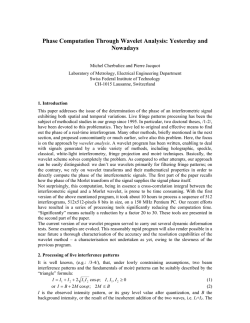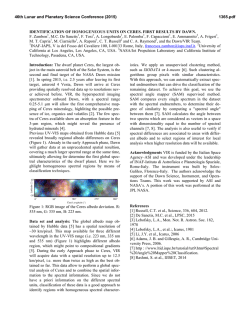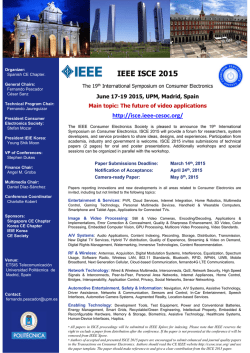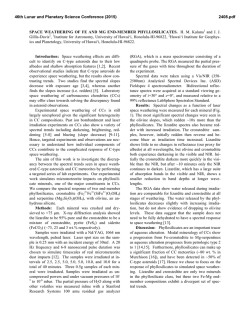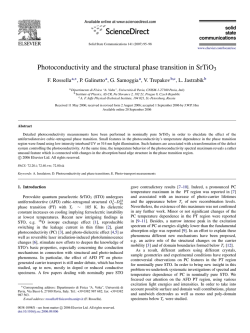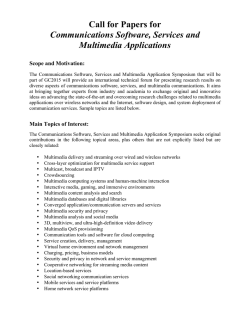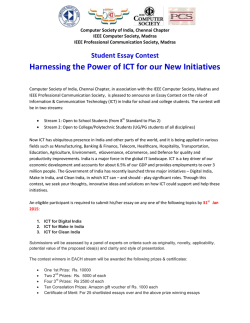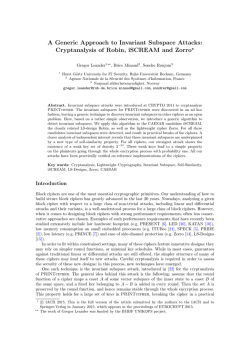
View PDF - Maxwell Science
Research Journal of Applied Sciences, Engineering and Technology 8(12): 1456-1460, 2014
ISSN: 2040-7459; e-ISSN: 2040-7467
© Maxwell Scientific Organization, 2014
Submitted: July 07, 2014
Accepted: August 26, 2014
Published: September 25, 2014
Face Recognition System Based on Spectral Graph Wavelet Theory
1
R. Premalatha Kanikannan and 2K. Duraiswamy
1
Anna University, Chennai,
2
K.S.R. College of Technology, Tiruchengode, Tamilnadu, India
Abstract: This study presents an efficient approach for automatic face recognition based on Spectral Graph Wavelet
Theory (SGWT). SGWT is analogous to wavelet transform and the transform functions are defined on the vertices
of a weighted graph. The given face image is decomposed by SGWT at first. The energies of obtained sub-bands are
fused together and considered as feature vector for the corresponding image. The performance of proposed system is
analyzed on ORL face database using nearest neighbor classifier. The face images used in this study has variations
in pose, expression and facial details. The results indicate that the proposed system based on SGWT is better than
wavelet transform and 94% recognition accuracy is achieved.
Keywords: Chebyshev polynomial, face recognition, nearest neighbor classifier, spectral graph wavelet theory
INTRODUCTION
In computer vision and machine learning,
automatic recognition of face has been a popular
research field for the past two decades. In face
recognition system, the comparison of test image with
the database images is done in many ways to identifies
one person. De Marsico et al. (2013) explained a novel
framework for real world face recognition in
uncontrolled settings. Its robustness comes from
normalization strategies to address pose and
illumination variations. It improves accuracy
performance compared to state-of-art methods, for
uncontrolled settings when the image acquisition
conditions are not optimal.
Zafeiriou et al. (2013) described a new database
collected in both 2D and 3D for real time face
recognition based on Photometric Stereo (PS). The
database is collected using a custom-made four-source
PS device designed to enable data capture with minimal
interaction necessary from the subjects. Four source PS
methods produce facial samples that achieve constantly
better recognition and verification performance than 3
sources PS regardless of the reconstruction methods
applied. Gradient information containing pixel wise
interaction
properties
within
small
scale
neighbourhoods is first considered in Vu (2013) for
face recognition systems. This information is then
incorporated over regions of larger scale and finally
encoded in more extended image patches by
considering their relationships. The obtained features
have several desirable properties and lead to accurate
yet fast face recognition systems.
Vageeswaran et al. (2013) explained a blur robust
face recognition algorithm. It is used to solve the
problems of blur and recognizing blurred and poorly
illuminated faces from remotely acquired images.
Based on set theoretic characterization, illumination
robust algorithm also implemented. These algorithms
are based on a generative model followed by nearest
neighbour classification between the query image and
the gallery space. A nonnegative sparse representation
approach, called two stages Sparse Representations
(TSR), for robust face recognition on a large-scale
database is described in He et al. (2013). Based on the
divide and conquer strategy, TSR decomposes the
procedure of robust face recognition into outlier
detection stage and recognition stage. In the first stage,
a general multi subspace framework is proposed to
learn a robust metric in which noise and outliers are
detected. In the second stage, based on the learned
metric and collaborative representation, an efficient
nonnegative sparse code algorithm is proposed to find
an approximation solution of sparse representation.
A linear discriminate regression classification
algorithm is implemented in Huang and Yang (2013a)
to boost the effectiveness of the Linear Regression
Classification (LRC) for face recognition. It embeds
discriminate analysis into the linear regression
classification algorithm for seeking an optimal
projection matrix such that the LRC on that subspace
has high discriminatory ability for classification. The
intrinsic structure of the error incurred by occlusion
from morphological feature and the probabilistic
distribution is reviewed in Li et al. (2013). Based on
these two methods, Structured Sparse Error coding
model for face recognition with occlusion is
implemented. This method is more stable and has
higher breakdown point in dealing with the occlusion
problems in face recognition.
Corresponding Author: R. Premalatha Kanikannan, Anna University, Chennai, India
1456
Res. J. App. Sci. Eng. Technol., 8(12): 1456-1460, 2014
Lu and Tan (2013) described a cost sensitive
subspace analysis approach for face recognition. It uses
a cost matrix specifying different costs corresponding
to different types of misclassifications, into two popular
and widely used discriminative subspace analysis
methods and devises the cost sensitive linear
discriminant analysis and cost sensitive marginal fisher
analysis methods, to achieve a minimum overall
recognition loss by performing recognition in these
learned low dimensional subspaces. A novel robust
kernel representation model with statistical local
features for robust face recognition is employed in
Yang et al. (2013). Kernel representation is represented
by methods, which are multipartition max pooling
technology is implemented to enhance the invariance of
local features to image registration error and robust
kernel representation model. It also adopts with robust
regression function as the measure to effectively handle
the occlusion in facial images.
A unitary regression classification algorithm
implemented in Huang and Yang (2013b) is used to
improve the robustness of face recognition, which could
achieve total minimum projection error. It minimizes
the total intra class reconstruction error from all classes
to find an optimal projection for linear regression
classification. In the recognition phase, the recognition
is determined by calculating the minimum projection
error on the unitary rotation subspace. Automatic
approach for matching surveillance quality facial
images to high-resolution images in frontal pose is
described in Biswas et al. (2013). The basic intuition is
to simultaneously transform the features from the probe
and the gallery images such that the distances between
them approximate the distances had the probe image
been taken in the same conditions as the gallery images.
An et al. (2013) employed a multi camera face
recognition system using dynamic bayesian network. It
is suitable for applications such as surveillance
monitoring in camera networks. This method uses
videos from multiple
cameras to
provide
complementary information for robust recognition
result. An approach that explicitly models the cross
modal data association is implemented in Tawari and
Trivedi (2013). Two different rule based data
association approaches are investigated. The use of
audio data could improve the recognition performance
in terms of computation as well as recognition
accuracy.
In this study, a new approach for face recognition
system based on Spectral Graph Wavelet Theory
(SGWT) is presented.
of the Laplacian. A measurable function of abounded
self-ad joint linear operator on a Hilbert space is
defined using the continuous functional calculus (Reed
and Simon, 1980). This is achieved using the spectral
representation of the operator. In particular, for our
spectral graph wavelet kernel g, the wavelet operator T g
= g(L) acts on a given function f by modulating each
Fourier mode as:
∧
Tg f (l ) = g (λ l ) fˆ (l )
(1)
Employing the inverse Fourier transforms yields:
(T f )(m ) = ∑ g (λ )fˆ (l )X (m )
N −1
g
Tgt
l
l
l =0
(2)
The wavelet operators at scale t are then defined by
= g (tL ) . It should be emphasized that even
though the “spatial domain” for the graph is discrete,
the domain of the kernel g is continuous and thus the
scaling may be defined for any positive real number t.
The spectral graph wavelets are then realized through
localizing these operators by applying them to the
impulse on a single vertex, i.e.:
ψ t ,n = Tgt δ n
(3)
Expanding this explicitly in the graph domain shows:
N −1
ψ t ,n (m ) = ∑ g (tλl )χ l* (n )χ l (m )
(4)
l =0
Formally, the wavelet coefficients of a given
function f are produced by taking the inner product with
these wavelets, as:
W f (t , n ) = ψ t , n , f
(5)
Using the orthonormality of the {χ l }, it can be seen
that the wavelet coefficients can also be achieved
directly from the wavelet operators, as:
( ) (n) = ∑ g (tλ ) f (l )χ (n)
W f (t ,n ) = Tgt f
N −1
l =0
l
l
(6)
By construction, the spectral graph wavelets ψ t,n ,
are all orthogonal to the null eigenvector χ 0 and nearly
orthogonal to χ l for λ l near zero. In order to stably
Spectral graph wavelet theory: The spectral graph
represent the low frequency content of f defined on the
wavelet transform (Hammond et al., 2011) is generated
vertices of the graph, it is convenient to introduce a
by wavelet operators that are operator-valued functions
1457
METHODOLOGY
Res. J. App. Sci. Eng. Technol., 8(12): 1456-1460, 2014
second class of waveforms, analogous to the low pass
residual scaling functions from classical wavelet
analysis. These spectral graph scaling functions have an
analogous construction to the spectral graph wavelets.
They will be determined by a single real valued
function h: R+ → R, which acts as a low pass filter and
satisfies h(0)>0 and h(x)→0 as x→0. The scaling
functions are then given by 𝜙𝜙𝑛𝑛 = T h δ n = h(L)δ n and the
coefficients by S f (n ) = φ n , f .
The proposed feature vector is computed for all selected
training samples and used for training the classifier.
The face image to be recognized is decomposed by
SGWT and the proposed feature vector for the
corresponding unknown face image is computed as in
the training step. Then the feature vector is compared
with that of each person feature vectors in the database
and recognized with a minimum distance method using
Euclidean distance.
RESULTS AND DISCUSSION
PROPOSED METHOD
The main step in the proposed face recognition
system is feature extraction. This module transforms the
input face image which is in the spatial domain into
SGWT, a frequency domain analysis similar to wavelet
transform. The primary motivation to use SGWT is that
they provide synchronized localization in both time and
frequency domain. Figure 1 shows the overall
automated process for face recognition based on
SGWT.
As SGWT is a filtering technique, the response
energies are used as features. The response energies are
calculated by squaring SGWT decomposed coefficients
at each sub-band. Then the sub-band energies are fused
to form the feature vector. Thus the feature vector
consists of energies of all sub-bands for recognition.
In this section, the assessment of the proposed face
recognition system based on SGWT is discussed. The
ORL face database (Samaria and Harter, 1994) is
chosen for evaluation due to the fact that the face
images in the database have high degree of variability
in expression, pose and facial details. This database
consists of 400 images of 40 individuals. Figure 2
shows all 10 views of a sample subject. All the images
in the ORL face database are considered for the
recognition test. The performance of the proposed
system is analyzed by increasing the training samples
and remaining samples are tested. The recognition
accuracy is used as performance measure.
As the features are extracted by decomposing the
input face image by SGWT, the performance of the
system is analyzed by changing the decomposition level
Fig. 1: Overall automated system for face recognition using spectral graph wavelet theory
1458
Res. J. App. Sci. Eng. Technol., 8(12): 1456-1460, 2014
Recognition Accuracy (%)
98
88
SGWT polynomial 10
SGWT polynomial 20
SGWT polynomial 30
SGWT polynomial 40
SGWT polynomial 50
83
78
73
68
Fig. 2: Sample face images of a subject from the ORL
database
Level 1
Level 2
Level 3
Level 4
Level 5
Decomposition level
Fig. 3: Recognition accuracy vs. polynomial order used in
SGWT on the ORL database
95
Recognition accuracy (%)
Table 1: Recognition accuracy using SGWT with polynomial order
of 10
# Training samples
-------------------------------------------------------------Decomposition
1
2
3
4
5
level
1
71.67
83.44
90.00
90.83
94.00
2
71.67
83.13
88.57
90.42
93.00
3
72.78
83.44
88.57
90.00
93.00
4
72.78
83.13
88.21
89.58
93.00
5
72.78
83.13
89.64
90.83
93.00
93
90
85
80
of SGWT. Table 1 shows the recognition accuracy
75
obtained by the proposed system. While calculating,
Wavelet transform
70
SGWT based system
SGWT decomposed image, the chebyshev polynomial
of Laplacian applied to the input vector is 10 and
65
Level 4 Level 5
Level 1 Level 2 Level 3
maximum of 50% images are used for training the
Decomposition level
nearest neighbour classifier.
The results show that the recognition accuracy of
Fig. 4: Recognition accuracy of proposed system vs. wavelet
the proposed approach increases as the number of
transform on the ORL database
training images increases. Also it is noted that the effect
on increasing the level decomposition does not affect
based face recognition is superior than wavelet based
the recognition accuracy. The proposed system
features.
achieves 94% accuracy while using 50% of training
images. Among the 200 test images only 12 face
CONCLUSION
images are wrongly recognized. As the decomposition
In this study, an efficient face recognition system
of SGWT depends on the chebyshev polynomial, the
based
on SGWT is proposed. SGWT is analogous to the
impact on changing the polynomial order is also
wavelet
transform. The face image is decomposed at
analyzed. Figure 3 shows the performance of the
various
level
of decomposition. The performance of the
proposed approach over different polynomial order
proposed approach is evaluated at each level and the
used.
computed recognition accuracy is also tabulated. The
It is clearly observed from the Fig. 3 that the
nearest neighbor classifier with Euclidean distance
change in the recognition accuracy is very low and the
measure is used for recognition. The experiments on
changes are in a narrow band while changing the
ORL database shows the effectiveness of the proposed
polynomial order. Hence, the polynomial order of 10 is
system for face recognition in comparison with wavelet
transform.
chosen for the proposed approach. The proposed face
recognition system using SGWT is compared with
REFERENCES
state-of-art wavelet transform technique. Figure 4
shows the computed recognition accuracy of proposed
An, L., M. Kafai and B. Bhanu, 2013. Dynamic
system in comparison with wavelet transform on the
Bayesian network for unconstrained face
ORL database.
recognition in surveillance camera networks. IEEE
It is seen that the proposed approach based on
J. Emerg. Sel. Top. Circ. Syst., 3(2): 155-164.
SGWT performs better than wavelet transform. The
Biswas, S., G. Aggarwal, P.J. Flynn and K.W. Bowyer,
recognition accuracy of the proposed system is over 3%
2013. Pose-robust recognition of low-resolution
approximately in comparison with wavelet transform.
face images. IEEE T. Pattern Anal., 35(12): 3037The experimental results also indicate that SGWT
3049.
1459
Res. J. App. Sci. Eng. Technol., 8(12): 1456-1460, 2014
De Marsico, M., M. Nappi, D. Riccio and H. Wechsler,
2013. Robust face recognition for uncontrolled
pose and illumination changes. IEEE T. Syst. Man
Cyb., 43(1): 49-163.
Hammond, D.K., P. Vandergheynst and R. Gribonval,
2011. Wavelets on graphs via spectral graph
theory. Appl. Comput. Harmon. A., 30(2): 129150.
He, R., W.S. Zheng, B.G. Hu and X.W. Kong, 2013.
Two-stage nonnegative sparse representation for
large-scale face recognition. IEEE T. Neural
Networ. Learn. Syst., 24(1): 35-46.
Huang, S.M. and J.F. Yang, 2013a. Linear discriminant
regression classification for face recognition. IEEE
Signal Proc. Let., 20(1): 91-94.
Huang, S.M. and J.F. Yang, 2013b. Unitary regression
classification with total minimum projection error
for face recognition. IEEE Signal Proc. Let., 20(5):
443-446.
Li, X.X., D.Q. Dai, X.F. Zhang and C.X. Ren, 2013.
Structured sparse error coding for face recognition
with occlusion. IEEE T. Image Process., 22(5):
1889-1900.
Lu, J. and Y.P. Tan, 2013. Cost-sensitive subspace
analysis and extensions for face recognition. IEEE
T. Inf. Foren. Sec., 8(3-4): 510-519.
Reed, M. and B. Simon, 1980. Methods of Modern
Mathematical Physics. Vol. 1: Functional Analysis.
Academic Press, NY.
Samaria, F.S. and A.C. Harter, 1994. Parameterisation
of a stochastic model for human face identification.
Proceedings of the 2nd IEEE Workshop on
Applications of Computer Vision, pp: 138-142.
Tawari, A. and M.M. Trivedi, 2013. Face expression
recognition by cross modal data association. IEEE
T. Multimedia, 15(7): 1543-1552.
Vageeswaran, P., K. Mitra and R. Chellappa, 2013.
Blur and illumination robust face recognition via
set-theoretic characterization. IEEE T. Image
Process., 22(4): 1362-1372.
Vu, N.S., 2013. Exploring patterns of gradient
orientations and magnitudes for face recognition.
IEEE T. Inf. Foren. Sec., 8(2): 295-304.
Yang, M., L. Zhang, S.C.K. Shiu and D. Zhang, 2013.
Robust kernel representation with statistical local
features for face recognition. IEEE T. Neural
Networ. Learn. Syst., 24(6): 900-912.
Zafeiriou, S., G.A. Atkinson, M.F. Hansen, W.A.P.
Smith, V. Argyriou, M. Petrou, M.L. Smith and
L.N. Smith, 2013. Face recognition and
verification using photometric stereo: The
photoface database and a comprehensive
evaluation. IEEE T. Inf. Foren. Sec., 8(1): 121-135.
1460
© Copyright 2026
